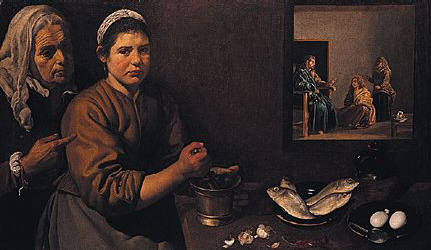Today being the feast day of St Martha, patron saint of housewives, this week’s picture is Diego Velazquez’s Kitchen Scene with Christ in the House of Martha and Mary. Painted in about 1618, the work is one of a group of so-called bodegones – a Spanish term for genre pictures featuring prominent still lifes of food and drink, derived from the word bodegon, meaning tavern or inn – with which Velazquez first made his name.
The picture is among other things a virtuoso demonstration of the young painter’s skill in capturing the different surfaces and textures of the world. The still life elements set out on the table before the gesticulating old lady and the sullen-faced young woman holding her mortar and pestle amount to a series of challenges met and triumphantly overcome. The raw materials for a simple meal of grilled fish and spiced mayonnaise have been observed and depicted with a nearly miraculous attention to detail: several cloves of papery-skinned garlic; a shrivelled red chilli pepper; four wet and silvery fish, so fresh that the brightness has not yet gone from their eyes; a jug of olive oil; and a pair of porcelain-white eggs, dully gleaming on a chipped, dark-glazed terracotta plate, beside a pewter spoon. Velazquez was not yet twenty when he painted the picture but he had, already, assembled all the ingredients of a startlingly precise naturalism.
The painter had finished his apprenticeship about a year earlier, impressing his teacher, Francisco Pacheco, with his prodigious abilities. Pacheco backed his young protégé in no uncertain terms, as he later wrote: “After five years of education and training, impressed by his virtue, integrity, and excellent qualities, and also by the promise of his great natural genius, I gave him my daughter in marriage.” It was a...

ITP 67: Kitchen Scene with Christ in the House of Martha and Mary by Diego Velazquez
29-07-2001

